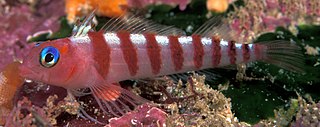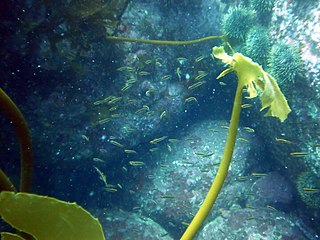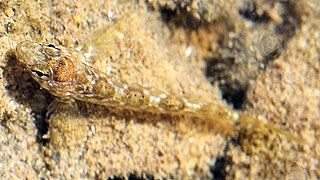
The spectacled triplefin, Ruanoho whero, is a triplefin in the genus Ruanoho. It is commonly found around New Zealand from depths of a few metres to about 30 m, most common in reef areas of broken rock. Its length is between 4 and 8 cm and its head is flattened with large eyes surrounded by a dark band giving rise to its common name. The head and fins have a pattern of fine blue lines. Its large pectoral fins are used as props when resting on the bottom where it spends most of its time.

The yellow-and-black triplefin, Forsterygion flavonigrum, a triplefin of the genus Forsterygion, is found around the north of the North Island of New Zealand at depths of between 15 and 30 m, in reef areas of broken rock. Its length is between 4 and 7 cm.

The blue-eyed triplefin, Notoclinops segmentatus, is a fish in the genus Notoclinops, commonly found around the North Island of New Zealand from depths of a metre to about 30 m, most common in reef areas of broken rock. Its length is between 3 and 6 cm and it is easily distinguished from other small fish by its iridescent blue eyes which give its name. There are nine red vertical bars running right round the body, and an orange tinge to the back and head.

Yaldwyn's triplefin, Notoclinops yaldwyni, is a fish of the genus Notoclinops, found around the North Island of New Zealand from low water to depths of about 5 metres, most common in reef areas of broken rock, but nowhere common. Its length is between 4 and 8 centimetres. It is a pale yellow-brown with a faint orange tinge to the head, and two or three rows of small black dots on the flanks.

The oblique-swimming triplefin, Forsterygion maryannae, is a triplefin, found along the north east coast of the North Island of New Zealand from depths of about 5 m to 50 m. They are the only triplefins not to spend most of their time resting on the bottom, instead swimming in loose schools of up to hundreds of individuals above rocky reefs. When swimming their head is higher than the tail, giving rise to their common name.

The blue dot triplefin, Notoclinops caerulepunctus, is a fish in the genus Notoclinops, found around offshore islands and exposed headlands of the eastern side of Northland, and the Bay of Plenty, on the North Island of New Zealand from depths of a metre or so to about 30 m, most common in reef areas of broken rock. Its length is only up to about 5 cm and it is the smallest of the triplefins in New Zealand.

The common triplefin, Forsterygion lapillum, is a fish of the genus Forsterygion, found around the coast of New Zealand down to depths of about 15 m. Its length is between 4 and 8 cm. It is commonly found in intertidal rock pools. It can also be found in water as deep as 30m, feeding primarily on crustaceans and polychaetes.

Bellapiscis medius,, the twister, is a triplefin fish of the family Tripterygiidae, commonly found around the coast of New Zealand. Its length is between 5 and 10 cm.

The New Zealand topknot, Notoclinus fenestratus, is a triplefin of the genus Notoclinus, found around the North Island of New Zealand in reef areas of broken rock and brown seaweed.
The scaly-headed triplefin, Karalepis stewarti, is a triplefin, the only species in the genus Karalepis. It is endemic to New Zealand where it is found around North Island, South Island, the Three Kings Islands, Snares Island and Stewart Island. It is a nocturnal species It occurs at depths of about 5 to 30 metres, in reef areas of broken rock. The specific name honours Andy Stewart of the Department of Fishes at the National Museum of New Zealand.
The mottled triplefin, Forsterygion malcolmi, is a triplefin of the genus Forsterygion, found around New Zealand at depths down to 30 m, in reef areas of broken rock. Its specific name honours Malcolm Francis of the Fisheries Research Centre in Wellington, New Zealand, who joined Hardy on his trips to collect specimens.

Bellapiscis lesleyae, the mottled twister, is a triplefin of the family Tripterygiidae, commonly found around the coast of New Zealand in rock pools and down to depths of about 5 m in reef areas of broken rock. Its length is up to 6 cm. The specific name of this blenny honours the New Zealand marine biologist Lesley Bolton who helped Hardy collect fishes in rockpools on the coast of New Zealand, including the type of this species.

Forsterygion is a genus of triplefins in the family Tripterygiidae native to coastal New Zealand, but also introduced to Tasmania, Australia.
The brown topknot, Notoclinus compressus, is a triplefin of the family Tripterygiidae, endemic to New Zealand in rock pools and from low water to depths of about 5 m, in reef areas of broken rock and large brown seaweed of genera Carpophyllum and Cystophora. Its length is up to about 8.5 cm.
Enneapterygius flavoccipitis, the yellownape triplefin or northern bicoloured triplefin, in Australia, is a species of threefin blenny in the genus Enneapterygius.
The northern yellow-black triplefin, also known as the northern Australian yellow-black triplefin, is a species of triplefin blenny in the genus Enneapterygius. It was described by German Ichthyologist Ronald Fricke in 1994. It is a tropical blenny, endemic to northern Australia, in the western Pacific and southeastern Indian Oceans. It is a non-migratory species which dwells in shallow tidal pools on coralline rock and in seagrass, and has been recorded swimming at a depth range of 0–15 m (0–50 ft). Male northern yellow-black triplefins can reach a maximum length of 2.8 centimetres.

Forsterygion capito, known commonly as the spotted robust triplefin, is a species of triplefin blenny in the genus Forsterygion. It was described by Jenyns in 1842. This species is endemic to New Zealand where it occurs around the North and South Islands, Stewart Island, Auckland Islands, Snares Islands, Antipodes Islands and Chatham Islands. The adults occur along sheltered coastal reefs and in harbours and bays with substrates consisting of rock and shell. They range in depth from intertidal pools to 12 metres (39 ft), or more. They prey on small benthic animals which are swallowed whole.

Forsterygion gymnotum, known commonly as the Tasmanian robust triplefin, is a species of triplefin blenny in the genus Forsterygion. It is native to coastal New Zealand, but has also been Introduced to Tasmania, Australia. It was described by Eric Oswald Scott in 1977 from Tasmania. It is thought to have reached Tasmania from New Zealand through shipments of osyters.

The estuarine triplefin or the cockabully is a species of triplefin blenny in the genus Forsterygion. It was described by Achille Valenciennes in 1836. It is found in the Southwest Pacific, throughout New Zealand.
Matanui bathytaton, known commonly as the Chatham deep-water triplefin, is a species of triplefin blenny in the genus Matanui. It was described by Graham S. Hardy in 1989. This species occurs at depths between 12 and 550 metres on waters off New Zealand including the Chatham Rise, southeast South Island, Auckland Islands, Antipodes Islands and Stewart Island.














